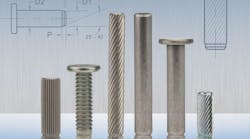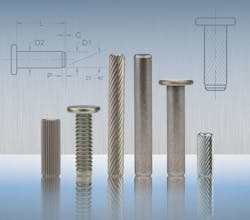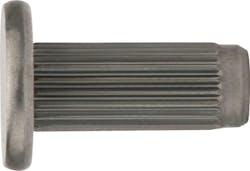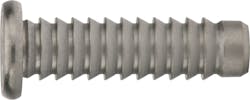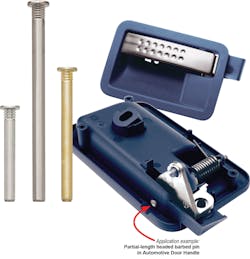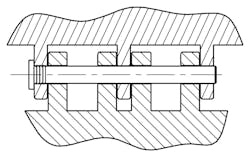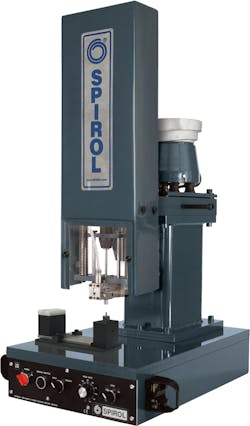Assemblies can be held together in many ways: bolts, rivets, screws and retaining pins, to name a few. Pinning represents one of the most economical fastening methods available. Pins generally cost less than other fasteners, require simple component designs, and install quickly and easily.
Pins are used for a wide variety of tasks:
• Fastening two or more components to each other.
• Acting as hinge pins, axles, or pivots.
• Locating or aligning two or more components to each other.
• Providing positive stop to limit movement of components within assemblies.
The challenge for designers is to choose the fastening method that provides the highest quality, long-term joint at the lowest manufacturing cost. For many applications, solid, self-retaining pins are the answer.
Here are some general situations for which solid pins may be most suitable:
• When a head is required for a positive stop or to attach a thin member to a thicker member of the assembly.
• When a smooth, uninterrupted surface is required such as when used with a pawl or other angular component.
• When a hollow pin is not suitable such as to plug a hole to restrict passage of liquids, for example.
• When there is a need to manually align several clearance holes.
• When increased bending or shear strength is required.
• When precise hole locations need to be maintained.
When a solid pin is held in place by being press-fit into an assembly either automatically or manually, it is important that the pin be harder than the host material. Otherwise, the pin deforms during installation. If more hardness is required, pins can be made from alloy steel or 400 stainless steel that is hardened after forming.
There are three common types of solid pins: straight, knurled, and barbed.
Straight pins, with or without heads, are uniform and smooth. Their chamfered ends are more consistent than tumbled edges, which makes installation with automatic equipment more consistent and reliable.
These pins are held in place retained by compressing the material around them, not the pin itself. They can be uses in plastics for press-fit applications, but the plastic must withstand compression on the order of 0.002 to .003 in. (0.05 to 0.08mm). These pins are often used to replace ground dowels in applications that do not require the tight tolerances of a ground dowel.
Knurled pins have either straight or helical knurls, and can either have heads or not. Unlike straight pins where retention is provided by the uniform interference between the pin and hole, knurled pins cut into the host to secure themselves. The displacement of host material into the valleys of the knurls also means there is more frictional contact area between the pin and hole, resulting in higher retention. With helical knurled pins, a 30° knurl forces the pin to rotate as it enters the hole, creating even more surface contact with the host. This results in even higher frictional forces, greater engagement, and better resistance to back out.
Barbed pins are designed specifically for use in plastic assemblies. The raised barbs angle backwards and opposite the direction of insertion for maximum retention. All barbed pins are provided with a generous pilot to facilitate alignment with the hole and ease installation.
There are many overlaps in the applications for these pins. Straight knurls have lower insertion forces than helical knurls, offer resistance to turning within the assembly, but provide limited retention when axially loaded. Therefore, straight knurls are often recommended when the pin will transmit torque such as when used as an axle to rotate a wheel. Helical knurls, on the other hand, resist both torque and push out when axially loaded.
Barbed pins are recommended for use in flexible plastics where the most resistance to axial force is needed. After installation, the plastic backfills into areas around the barbs, resulting in maximum retention. Barbs are not appropriate for brittle plastics or those containing high percentages of fillers. As barbs are a radial feature, they do not resist rotation of two components relative to one another. For this requirement, straight or helical knurls should be used.
It is sometimes necessary to simplify assembly, or increase retention or some other function to modify the knurl length or location on the pin. The location of the knurl can be customized to suite design requirements. More specifically, rather than having the knurls or barbs spanning the full length of the pin, a partial-length knurl or barb, or set of partial-length knurls (or barbs) can be located anywhere along the length of a solid pin to coincide with the component in which it will be retained.
Solid retain pins can be made of a variety of metals Here are the most common ones:
Austenitic stainless steel provides excellent corrosion protection against normal environmental conditions. It withstands fresh water and atmospheric marine conditions well, and is suitable for many other industrial conditions including acidic environments. All austenitic stainless solid pins are passivated.
Passivating stainless steel pins involves removing surface contaminates such as embedded tool steel and other free-iron particles. The purpose is to remove embedded iron; not to clean the part. While all stainless steel pins are usually passivated, there are some critical applications that absolutely require passivation such as medical devices, components used in the food or drug industry, fuel system applications, and any application going into a clean environment.
Low-carbon steel is one of the most versatile pin materials. It is readily available and is the most economical standard solid pin materials if it is not plated or coated. Fortunately, low-carbon pins are usually coated in an oil that evaporates over time, leaving a dry-to-the-touch rust preventative. Additional coatings and finishes can be applied to improve corrosion resistance. For some applications, however, it may be more appropriate and cost beneficial to specify stainless steel when a high level of corrosion resistance is required.
Alloy steel is used for applications requiring higher shear strength than standard materials provide, or when additional hardness is required to ensure the pin is harder than the host material into which the pin is installed.
Aluminum is lightweight, lead-free, and has sufficient strength for most plastic applications. Aluminum is less than half the weight of steel and does not require any supplemental coatings or platings to provide the corrosion protection appropriate in most environments.
With so many different solid pins to choose from, it is recommended that application engineers who specialize in fastening and joining be consulted to ensure the optimum design is employed for each application.
Christie L. Jones is Market Development Manager at Spirol International Corp., Danielson, Conn.
